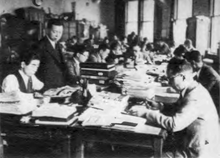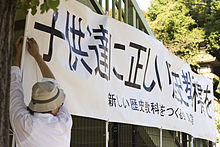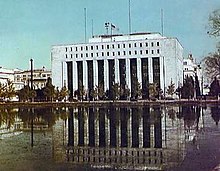In Japan, Article 21 of the Japanese Constitution guarantees freedom of expression and prohibits formal censorship. What censorship does exist is often carried out through Article 175 of the Criminal Code of Japan. Historically the law has been interpreted in different waysâ€"recently it has been interpreted to mean that all pornography must be at least partly censored; however, there have been very few arrests based on this law.
History

After the Meiji Restoration in 1868, which marked a major political shift in Japan, the government began heavy censorship of Western ideas, pornography and any political writings critical of the Emperor of Japan and government, wanting to control the spread of information. Censorship of materials increased from this point, often using ongoing wars to increase police powers and penalties. In 1928, the death penalty was added to the list of punishments deemed acceptable for certain violations. This continued, eventually to the Information and Propaganda Department (æƒ…å ±éƒ¨, JÅhÅbu) being elevated to the Information Bureau (æƒ…å ±å±€, JÅhÅ Kyoku) in 1940, which consolidated the previously separate information departments from the Army, Navy and Foreign Ministry under the aegis of the Home Ministry. The new Bureau had complete control over all news, advertising and public events. The following year revision of the National Mobilization Law (国家ç·å‹•å"¡æ³•, Kokka SÅdÅin HÅ) eliminated freedom of the press entirely, doing things such as forcing papers in each prefecture to either merge into one paper or cease publication, with all articles by the paper having to be screened by government censors before they could be published.
Occupation of Japan
After the surrender of Japan in 1945, the Supreme Commander of the Allied Powers abolished all forms of censorship and controls on Freedom of Speech, which was also integrated into Article 21 of the 1947 Constitution of Japan. However, press censorship remained a reality in the post-war era, especially in matters of pornography, and in political matters deemed subversive by the American government during the occupation of Japan.
According to David M. Rosenfeld:
Not only did Occupation censorship forbid criticism of the United States or other Allied nations, but the mention of censorship itself was forbidden. This means, as Donald Keene observes, that for some producers of texts "the Occupation censorship was even more exasperating than Japanese military censorship had been because it insisted that all traces of censorship be concealed. This meant that articles had to be rewritten in full, rather than merely submitting XXs for the offending phrases." (Dawn to the West, New York: Henry Holt, 1984). 967.
Pornography
Due to the current interpretation of Article 175 of the Criminal Code of Japan, which forbids distributing "indecent" materials, it is believed that most pornography in Japan must be at least partially censored. The primary means is to put a digital "mozaiku" (mosaic) over genitalia. There have, however, been very few arrests for violations of this law.
The most recent trial based on this law, the first in 20 years, was the conviction of Suwa Yuuji in January 2004 for his hentai manga Misshitsu. He was originally fined 500,000 yen(About 4,900USD) and avoided jail time by pleading guilty. When he appealed the case to the Supreme Court of Japan on arguments that the manga was not as indecent and explicit as much material on the Internet and that Article 175 violated the Japanese Constitution's protection of freedom of expression, the Court upheld the ruling and the fine was tripled to 1.5 million yen.
After Yuuji's conviction, a number of bookstores and chains removed their adults-only section. Their motivation has been attributed to the outcome, in a "chilling effect".
On the July 2013, the three staff members from the Core Magazine were arrested for having their manga almost censored. He pleaded guilty later in December 2013. As a result of the arrest, numerous artists and publishers began to have more self-censorship in attempt to avoid the obscenity charge led by police.
See also
- Asahi Shinbun
- Computer Entertainment Rating Organizationâ€"a Japanese rating organization for video games
- Constitution of Japan#Individual rights
- Eirinâ€"the Japanese film rating organization
- Internet censorship and surveillance in Japan
- Japanese history textbook controversies
- Nihon Ethics of Video Association (NEVA)â€"a Japanese rating organization for videos
- Tokyo Metropolitan Ordinance Regarding the Healthy Development of Youthsâ€"the Tokyo law that regulates young people's access to "harmful" publications
- Uyoku dantai ("right wing groups")
- Kotobagariâ€"self-censorship and euphemisms in Japanese
Notes
.svg/125px-Merchant_flag_of_Japan_(1870).svg.png)
References

- Allison, Anne. Permitted and Prohibited Desires: Mothers, Comics, and Censorship in Japan. Berkeley, California: University of California Press, 2000. ISBN 0-8133-1698-7.
- Hirano, KyÅko. Mr. Smith Goes to Tokyo: The Japanese Cinema Under the American Occupation, 1945â€"1952. Washington, D.C.: Smithsonian Institution, 1992. ISBN 1-56098-157-1, ISBN 1-56098-157-1. OCLC 25367560.
- Mitchell, Richard H. Censorship in Imperial Japan. Princeton, N.J.: Princeton University Press, 1983. ISBN 0-691-05384-7. OCLCÂ 9219486.
- Rubin, Jay. Injurious to Public Morals: Writers and the Meiji State. Seattle: University of Washington Press, 1984. ISBN 0-295-96043-4.
Further reading

- Coyne, Fumiko Hoshida (1967). Censorship of Publishing in Japan, 1868â€"1945 (M.A. thesis). University of Chicago. OCLC 77328426.Â
- da Silva, JoaquÃn (8 May 2014). "Obscenity and Article 175 of the Japanese Penal Code: A Short Introduction to Japanese Censorship". Eiga9.Â
- Dobbins, Amanda (February 2009). "Obscenity In Japan: Moral Guidance Without Legal Guidance". Retrieved 10 March 2011.Â
- Hirano, Keiji (3 September 2003). "Obscenity trial prompts freedom-of-speech outcry". The Japan Times.Â
- Ibusuki, Makoto (Winter 1997). "Legal aspects of cyber-porn in Japan". Lex Electronica (Université de Montréal) 3 (1). Retrieved 10 March 2011.Â
- ItÅ, TasaburÅ (March 1972). "The Book Banning Policy of The Tokugawa Shogunate". Acta Asiatica (The TÅhÅ Gakkai (The Institute of Eastern Culture)) (22): 36â€"61.Â
- * Kanemitsu, Dan (22 August 2012). "The Uneasy Ceasefire of 2012: Revised Tokyo Ordinance's Current Status". Dan Kanemitsu's Paper Trail. Retrieved 24 August 2012. Updates the story of "Bill 156", which revised the Tokyo Youth Healthy Development Ordinance in 2011.
- Shingo (9 November 2007). "Editor’s Desk: chronicling the erosion of 2D free speech". Heisei Democracy. Retrieved 10 March 2011.Â
- Abel, Jonathan E. (18 August 2012). Redacted: The Archives of Censorship in Transwar Japan. University of California Press. ISBNÂ 9780520273344.Â
Posting Komentar